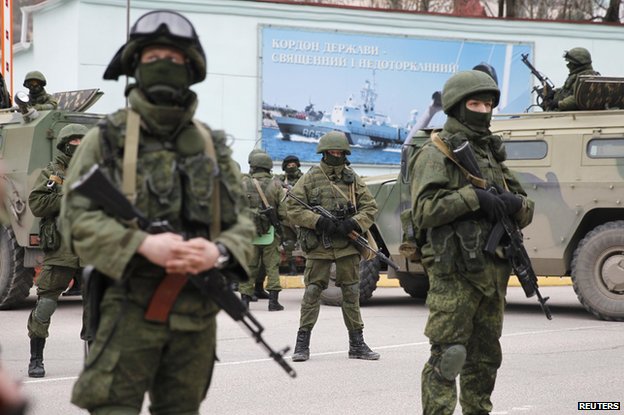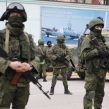
Myth and Reality—A Net Assessment of Russia’s ‘Hybrid Warfare’ Strategy Since the Start of 2014 (Part Two)
Publication: Eurasia Daily Monitor Volume: 11 Issue: 185
By:

Following Russia’s annexation of Crimea in March 2014, and Moscow’s mixture of threating full-scale invasion of Ukraine’s east combined with promoting separatism, analysts seized on an earlier article written by General Valeriy Gerasimov as offering a conceptual framework for those actions. Collectively, journalists quickly settled on describing this strategy by using the phrase “hybrid warfare,” though the original use in Gerasimov’s article was actually “non-linear” warfare (see Part One of this article in EDM, October 17; also see EDM, September 17).
Gerasimov’s March 2014 piece ended with a call to reinvigorate Russian military science in order to modernize the military to fight 21st-century conflicts. He cited the great Soviet military theorist Alexander Svechin, stressing that war is “extremely difficult to predict,” and that each conflict has its own line of strategic behavior requiring a particular logic and “not the application of a pattern.” The point was not lost on the country’s foremost military theorist, Army-General Makhmut Gareev, the president of the Academy of Military Sciences. In an article in May 2014, Gareev called for the lessons learned from the success of the Crimean operation to be examined and acted upon by Moscow (see EDM, May 6; Voyenno Promyshlennyy Kuryer, February 27, 2013).
However, by May 2014, those lessons were difficult to distinguish as the application of hard and soft power that dislodged Crimea from Ukraine had been submerged in several concurrent narratives: ranging from the versions in the Russian and Ukrainian media, to Western interpretations. The search for the specifics of Russian non-linear warfare, consistent with existing military science, would therefore demand a defragmentation of these contradictory narratives. The actual force mix used in Crimea, which appeared to rehearse the use of forces assigned to an evolving rapid reaction force, also contained an element of interest to other Russian military theorists. This seemed to mark a transition in the use of special forces (spetsnaz) to a more clearly defined combat- rather than reconnaissance-based role (RIA Novosti, May 16).
By September 2014, Colonel-General Anatoly Zaitsev assessed the implications of the Crimea operation in terms of the role of commandos in both offensive and defensive modes, arguing that a modern army must be able to fight without a front line. Zaitsev’s thinking, in other words, follows the same dynamics as earlier discussions of Russian views on future warfare. The “generations of wars” theme recurs, with the ultimate focus placed on “network-centric” and “non-contact” combat. Zaitsev notes that the North Atlantic Treaty Organization’s (NATO) intelligence missed everything concerning the Crimea operation, primarily due to Russian forces observing strict radio silence; Russia also made skilful use of the base in Sevastopol and military transport shipping from the Black Sea Fleet to redeploy personnel and equipment. Zaitsev then highlights the “sudden appearance of formidable, armed ‘polite people’ without insignia, where it was necessary to prevent an armed intervention” from local units (Voyenno Promyshlennyy Kuryer, September 3).
For Zaitsev, one of the “lessons learned” from the Crimea operation was related to the use of Russian commando units to seal off key infrastructure as forces spread across the peninsula. Zaitsev states:
These actual successes, critical in avoiding the Ukrainian forces opening fire on Russian troops, were no accident but the work of highly specialised GRU (military intelligence) Spetsnaz forces following strict orders. According to Zaitsev, this has implications for the future protection of critical infrastructure on Russian territory, including the protection of nuclear facilities (Voyenno Promyshlennyy Kuryer, September 3). Part of the mystery surrounding the lack of response from Ukrainian forces in Crimea during the operation lies precisely in this area. Russian commando units sealed off local bases, cut communications, and operated under strict orders to avoid opening fire or, if needed, to fire above the heads of enemy forces. The Russian forces were also ordered to allow Ukrainian personnel to contact their families and offered preferential defection terms for Ukrainian troops switching to join the Russian Armed Forces—including the same terms and conditions but without taking the oath of allegiance (Author’s interviews, May 2014).
Thus, for the author of the March 2014 Gerasimov article (whether or not it was actually General Staff head Valeriy Gerasimov) or specialists such as General Zaitsev, the internal military discussion is about developing tactics and methods that reflect the fact that the very means and methods of modern warfare have fundamentally changed. This includes a Russian understanding of using “weapons of new physical principles” or technological advances that occur during armed conflict where one side gains battlefield superiority over the other by exploiting a more effective means to direct firepower. In this military theory, the discussion is about generations of warfare and moving to non-contact or network-centric methods. The Russian military has neither a developed nor agreed-upon doctrinal version of these concepts, let alone a fully worked out “non-linear” approach. Svechin’s dictum about war not being about the “application of a pattern” holds true for Russian military theory today. The point is that non-linear doctrine and its tactics are in a state of experimentation and evolution—hence, Moscow is unlikely to repeat precisely the same approach or pattern when non-linear warfare is used next (Voyenno Promyshlennyy Kuryer, September 3; see EDM, May 6; Voyenno-Promyshlennyy Kuryer, February 27, 2013).
These issues are important for NATO planners as they consider how to boost security in the Alliance’s East and deal with any Russian actions below the threshold of Article Five. This will also come into play as the force structure of the new “spearhead” takes shape—which is aimed at strengthening security in Central Eastern Europe and the Baltic States by consolidating the NATO Reaction Force and building it upon a rotational basing structure. NATO military planners require 18 months to two years to plan and develop new exercise scenarios, meaning that Moscow will see no more than token tinkering with the “spearhead” force until 2016. Meanwhile, however, NATO decision makers risk planning responses to a nebulous target, since Russia’s “non-linear” warfare methods—in embryonic use in Ukraine since the beginning of 2014—will likely witness further refinement.




